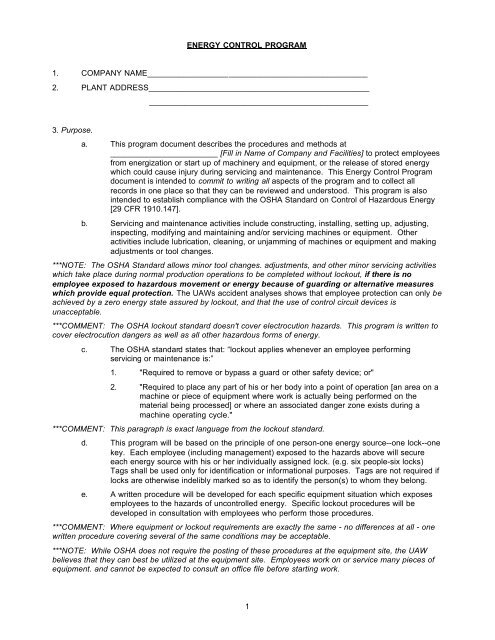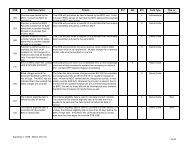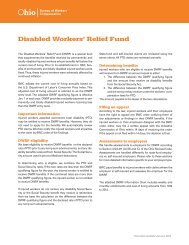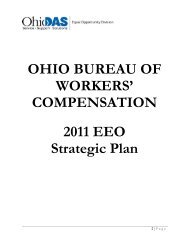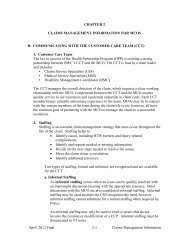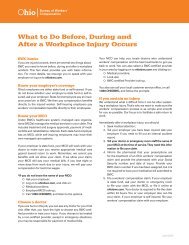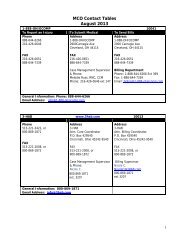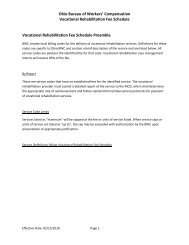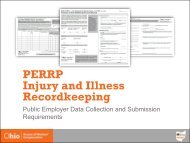Lockout / Tagout - Ohio Bureau of Workers' Compensation
Lockout / Tagout - Ohio Bureau of Workers' Compensation
Lockout / Tagout - Ohio Bureau of Workers' Compensation
Create successful ePaper yourself
Turn your PDF publications into a flip-book with our unique Google optimized e-Paper software.
ENERGY CONTROL PROGRAM<br />
1. COMPANY NAME_________________________________________________<br />
2. PLANT ADDRESS_________________________________________________<br />
_________________________________________________<br />
3. Purpose.<br />
a. This program document describes the procedures and methods at<br />
________________________ [Fill in Name <strong>of</strong> Company and Facilities] to protect employees<br />
from energization or start up <strong>of</strong> machinery and equipment, or the release <strong>of</strong> stored energy<br />
which could cause injury during servicing and maintenance. This Energy Control Program<br />
document is intended to commit to writing all aspects <strong>of</strong> the program and to collect all<br />
records in one place so that they can be reviewed and understood. This program is also<br />
intended to establish compliance with the OSHA Standard on Control <strong>of</strong> Hazardous Energy<br />
[29 CFR 1910.147].<br />
b. Servicing and maintenance activities include constructing, installing, setting up, adjusting,<br />
inspecting, modifying and maintaining and/or servicing machines or equipment. Other<br />
activities include lubrication, cleaning, or unjamming <strong>of</strong> machines or equipment and making<br />
adjustments or tool changes.<br />
***NOTE: The OSHA Standard allows minor tool changes. adjustments, and other minor servicing activities<br />
which take place during normal production operations to be completed without lockout, if there is no<br />
employee exposed to hazardous movement or energy because <strong>of</strong> guarding or alternative measures<br />
which provide equal protection. The UAWs accident analyses shows that employee protection can only be<br />
achieved by a zero energy state assured by lockout, and that the use <strong>of</strong> control circuit devices is<br />
unacceptable.<br />
***COMMENT: The OSHA lockout standard doesn't cover electrocution hazards. This program is written to<br />
cover electrocution dangers as well as all other hazardous forms <strong>of</strong> energy.<br />
c. The OSHA standard states that: “lockout applies whenever an employee performing<br />
servicing or maintenance is:”<br />
1. "Required to remove or bypass a guard or other safety device; or"<br />
2. "Required to place any part <strong>of</strong> his or her body into a point <strong>of</strong> operation [an area on a<br />
machine or piece <strong>of</strong> equipment where work is actually being performed on the<br />
material being processed] or where an associated danger zone exists during a<br />
machine operating cycle."<br />
***COMMENT: This paragraph is exact language from the lockout standard.<br />
d. This program will be based on the principle <strong>of</strong> one person-one energy source--one lock--one<br />
key. Each employee (including management) exposed to the hazards above will secure<br />
each energy source with his or her individually assigned lock. (e.g. six people-six locks)<br />
Tags shall be used only for identification or informational purposes. Tags are not required if<br />
locks are otherwise indelibly marked so as to identify the person(s) to whom they belong.<br />
e. A written procedure will be developed for each specific equipment situation which exposes<br />
employees to the hazards <strong>of</strong> uncontrolled energy. Specific lockout procedures will be<br />
developed in consultation with employees who perform those procedures.<br />
***COMMENT: Where equipment or lockout requirements are exactly the same - no differences at all - one<br />
written procedure covering several <strong>of</strong> the same conditions may be acceptable.<br />
***NOTE: While OSHA does not require the posting <strong>of</strong> these procedures at the equipment site, the UAW<br />
believes that they can best be utilized at the equipment site. Employees work on or service many pieces <strong>of</strong><br />
equipment. and cannot be expected to consult an <strong>of</strong>fice file before starting work.<br />
1


